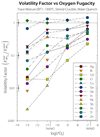Earth's volatile contents established by melting and vaporization
- PMID: 28959970
- PMCID: PMC6485635
- DOI: 10.1038/nature23645
Earth's volatile contents established by melting and vaporization
Abstract
The silicate Earth is strongly depleted in moderately volatile elements (such as lead, zinc, indium and alkali elements) relative to CI chondrites, the meteorites that compositionally most closely resemble the Sun. This depletion may be explained qualitatively by accretion of 10 to 20 per cent of a volatile-rich body to a reduced volatile-free proto-Earth, followed by partial extraction of some elements to the core. However, there are several unanswered questions regarding the sources of Earth's volatiles, notably the overabundance of indium in the silicate Earth. Here we examine the melting processes that occurred during accretion on Earth and precursor bodies and report vaporization experiments under conditions of fixed temperature and oxygen fugacity. We find that the pattern of volatile element depletion in the silicate Earth is consistent with partial melting and vaporization rather than with simple accretion of a volatile-rich chondrite-like body. We argue that melting and vaporization on precursor bodies and possibly during the giant Moon-forming impact were responsible for establishing the observed abundances of moderately volatile elements in Earth.
Conflict of interest statement
The authors declare that they have no competing financial interests.
Figures




Comment in
-
Geochemistry: Evaporating planetesimals.Nature. 2017 Sep 27;549(7673):461-462. doi: 10.1038/549461a. Nature. 2017. PMID: 28959977 No abstract available.
References
-
- Palme H, O'Neill H. Treatise on geochemistry volume 3. Ch. 1. Elsevier; 2014. pp. 1–39.
-
- O'Neill HS. The Origin of the Moon and the Early History of the Earth - a Chemical-Model .2. The Earth. Geochimica et Cosmochimica Acta. 1991;55:1159–1172. doi: 10.1016/0016-7037(91)90169-6. - DOI
-
- Schönbächler M, Carlson RW, Horan MF, Mock TD, Hauri EH. Heterogeneous accretion and the moderately volatile element budget of Earth. Science. 2010;328:884–887. - PubMed
-
- Wang ZC, Laurenz V, Petitgirard S, Becker H. Earth's moderately volatile element composition may not be chondritic: Evidence from In, Cd and Zn. Earth and Planetary Science Letters. 2016;435:136–146. doi: 10.1016/j.epsl.2015.12.012. - DOI
-
- Witt-Eickschen G, Palme H, O'Neill HSC, Allen CM. The geochemistry of the volatile trace elements As, Cd, Ga, In and Sn in the Earth's mantle: New evidence from in situ analyses of mantle xenoliths. Geochimica et Cosmochimica Acta. 2009;73:1755–1778. doi: 10.1016/J.Gca.2008.12.013. - DOI
Publication types
LinkOut - more resources
Full Text Sources
Other Literature Sources

